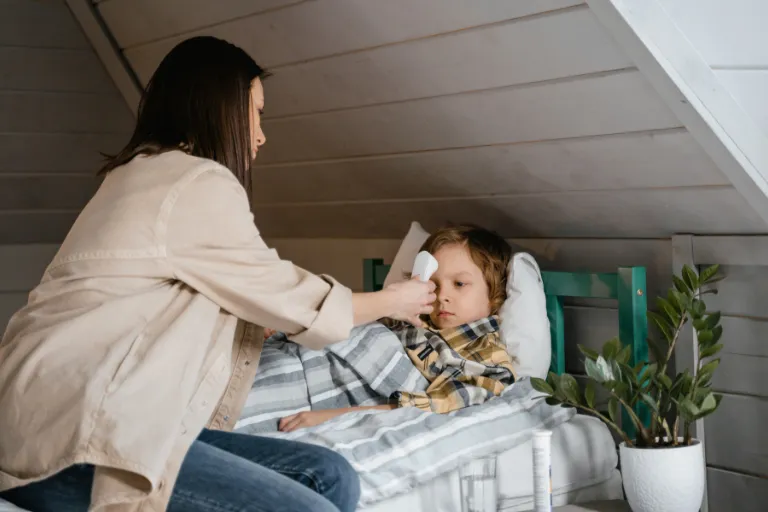Key Points
- Fever is a natural immune response, not always a sign of something dangerous.
- Most childhood fevers can be safely managed at home with hydration, comfort measures, and observation.
- Parents should watch for red-flag symptoms—such as breathing trouble, persistent high fever, or lethargy—that require prompt medical care.
- Safe use of over-the-counter medications is important; avoid outdated remedies like cold baths or rubbing alcohol.
- Understanding fever helps reduce “fever phobia” and empowers families to care for children with confidence.
When a Warm Forehead Sparks Worry
It usually begins in the middle of the night. A child stirs restlessly, their forehead unusually warm. A quick thermometer check shows 102°F. Parents, jolted awake, face the familiar surge of worry: Is this something I can handle at home—or should we head straight to urgent care?
For many families, fever in children is one of the most common—and most anxiety-inducing—health experiences. Up to half of parents bring children to a health professional for fevers that could often be safely managed at home . The challenge is distinguishing when a fever is simply part of the body’s defense system, and when it signals something more serious.
Fever as the Body’s Built-In Defense
A fever is not an illness in itself—it’s a response. When the immune system detects infection, the brain’s thermostat rises, creating a hotter internal environment that makes it harder for viruses and bacteria to thrive . In children, whose immune systems are still developing, fevers are especially common.
The American Academy of Pediatrics (AAP) notes that fever alone is rarely harmful; what matters more is the child’s overall behavior and accompanying symptoms . Still, persistent or very high fevers can put children at risk for dehydration or, in some cases, trigger febrile seizures—brief episodes of shaking that, while frightening, are typically not harmful .
Looking Beyond the Thermometer
How can parents tell when a fever can be managed at home versus when professional care is needed? A helpful approach is to look beyond the number on the thermometer.
Signs that a fever may be safely monitored at home:
- Child is alert and responsive, even if more tired than usual.
- Drinking fluids and producing urine.
- Breathing comfortably.
- Fever below 104°F (40°C) in children over 3 months old .
Red flags that require medical attention:
- Any fever in an infant under 3 months (≥100.4°F / 38°C).
- Fever lasting more than 3 days.
- Severe lethargy, persistent crying, or unresponsiveness.
- Difficulty breathing, rapid breathing, or bluish lips.
- Signs of dehydration: dry mouth, no tears, very few wet diapers.
- Stiff neck, severe headache, or sensitivity to light.
- Rash that spreads quickly or looks like bruising .
These guidelines come from pediatric associations such as the AAP and CDC, which emphasize pairing temperature with overall behavior and context .
Comfort First in Caring for a Fever
When a child has a mild to moderate fever without alarming symptoms, home care focuses on comfort and hydration.
Hydration and Fluids
Fever causes fluid loss through sweating and faster breathing. Offer frequent sips of water, diluted juice, or oral rehydration solutions. For infants, continue breast milk or formula .
Rest and Calm
Children often need extra rest, but they don’t need to stay in bed if they feel up to quiet play. Comfort and reassurance can be just as important as sleep.
Clothing and Environment
Dress children in lightweight clothing and keep the room comfortably cool. Over-bundling can trap heat and worsen discomfort .
Medications When and How
Acetaminophen (Tylenol) and ibuprofen (Motrin, Advil) can lower fever and ease discomfort, but they are not required for every fever . These should be used primarily if the child is uncomfortable, not simply because the thermometer shows a high number.
- Acetaminophen safe for children over 2 months.
- Ibuprofen safe for children over 6 months.
- Never give aspirin to children, due to the risk of Reye’s syndrome .
Always follow weight-based dosing guidelines and avoid overlapping multiple products containing the same ingredient—a common source of accidental overdose .
What Not to Do
- Avoid cold baths, ice packs, or rubbing alcohol; these methods can cause shivering, discomfort, or even dangerous reactions .
- Don’t force food—hydration is more critical than meals during a fever.
Fever Myths That Still Worry Parents
Researchers have documented what they call “fever phobia”: the fear among many parents that fever itself is dangerous. A 2016 study in Pediatrics found that nearly half of caregivers worried that untreated fever would rise to dangerous levels, despite evidence that the body has natural limits .
The truth: most fevers resolve on their own within a few days, as the immune system clears the underlying infection. The real danger often comes from dehydration, secondary infections, or delayed medical care when serious symptoms are ignored .
Fever Traditions Around the World
Around the world, cultural practices for fever vary. In some countries, herbal teas or cool compresses are traditional remedies. Others emphasize sweat-inducing blankets, hoping to “sweat out” the fever. While some of these practices can provide comfort, pediatric experts caution against methods that overheat or rapidly chill the body .
What remains universal: attentive caregiving, hydration, and recognizing when to seek medical help.
What Every Parent Should Remember
Fevers are one of childhood’s most common health hurdles. They can be unsettling, but they are also a powerful sign of the body’s natural defenses at work. By focusing on comfort, hydration, and careful monitoring, parents can often manage fevers at home with confidence.
The key is knowing when to call for help. If your child is very young, has persistent or unusually high fever, or shows any red-flag symptoms, don’t wait—reach out to a health professional. For the majority of fevers, however, reassurance and simple home care are the best medicine.
Where to Learn More
- American Academy of Pediatrics: Fever and Your Child
- Centers for Disease Control and Prevention: Caring for a Sick Child
- World Health Organization: Child Health Guidelines
The article does not in any way constitute as medical advice. Please seek consultation with a licensed medical professional before starting any treatment. This website may receive commissions from the links or products mentioned in this article.
Subscribe for Free for more insightful health articles tailored to your needs.
Sources
- Schmitt BD. Fever in children: Pearls and pitfalls. Contemporary Pediatrics. 2015.
- El-Radhi AS. Why is the evidence not affecting the practice of fever management? Arch Dis Child. 2008. Link
- American Academy of Pediatrics. Fever and Your Child. HealthyChildren.org
- Steering Committee on Quality Improvement and Management, AAP. Febrile seizures: Guideline for the neurodiagnostic evaluation. Pediatrics. 2011.
- Centers for Disease Control and Prevention. Caring for a Sick Child. CDC.gov
- World Health Organization. Pocket Book of Hospital Care for Children. WHO. 2013.
- National Institute of Neurological Disorders and Stroke. Reye’s Syndrome Information Page. NINDS
- U.S. Food & Drug Administration. Don’t Overuse Acetaminophen. FDA Consumer Updates. FDA.gov
- Sullivan JE, Farrar HC. Fever and antipyretic use in children. Pediatrics. 2011.
- Crocetti M, Moghbeli N, Serwint J. Fever phobia revisited: Have parental misconceptions about fever changed in 20 years? Pediatrics. 2001.



